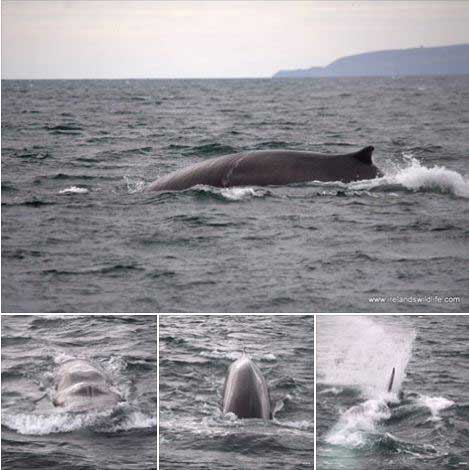LATEST
NEWS:
27
June 2016

Killer
Whale, Orcinus orca, named 'John
Coe"
off
the coast at the Blasket
Islands in County Kerry
Photographs
by Richard
Creagh Photography
The
famous Killer Whale, Orcinus orca,
named 'John Coe"
was spotted back off the extreme south-west coast of Ireland, seen by
Nick
Massett off Slea
Head, Dingle
Peninsula, County
Kerry. This whale
is quite easily recognised by the large notch on the base of the trailing
edge of his dorsal fin, a feature which makes him unique and easily recognisable.
John
Coe is perhaps one of the best known Killer
Whales in the seas around the British Isles,
having been first photographed by
Dr. Peter
Evans, Sea Watch Foundation,
33 years ago, off the Scottish Hebrides back in 1983.
He was of adult age even back then, and as with many members of this ageing
remnant sub-pod of eight adults, he is old by any standards. Today
there are grave concerns for the future survival of this pod whose territory
extends into Irish waters. One major concern is that it is many years
since there has been any new additions to this group, and zero recruitment
means that this group will ultimately die off; something which would be
a great loss to our marine biodiversity.
23
June 2016
A
large 20 kg Angel Shark, Squatina
squatina, was caught by angler Steve
Denning (from Magor, south Wales) off in the
Bristol Channel off Cardiff
Bay just out from Aberthaw
Power Station in South Wales. It was weighed and returned alive.
This
rare and protected shark is thought to be extinct in the English Channel
and still extremely rare in the Bristol Channel.
BMLSS
Angel Sharks
21
June 2016
Bottlenose Dolphins,
Tursiops
truncatus, have been known since 2007
to attack
and kill Harbour Porpoises,
Phocoena
phocoena, in the Moray
Firth off north-east Scotland. However, this action is rarely captured
on camera as it occurs when the dolphin
tosses a young porpoise
in the air.
Bottlenose
Dolphins
of the Moray Firth |
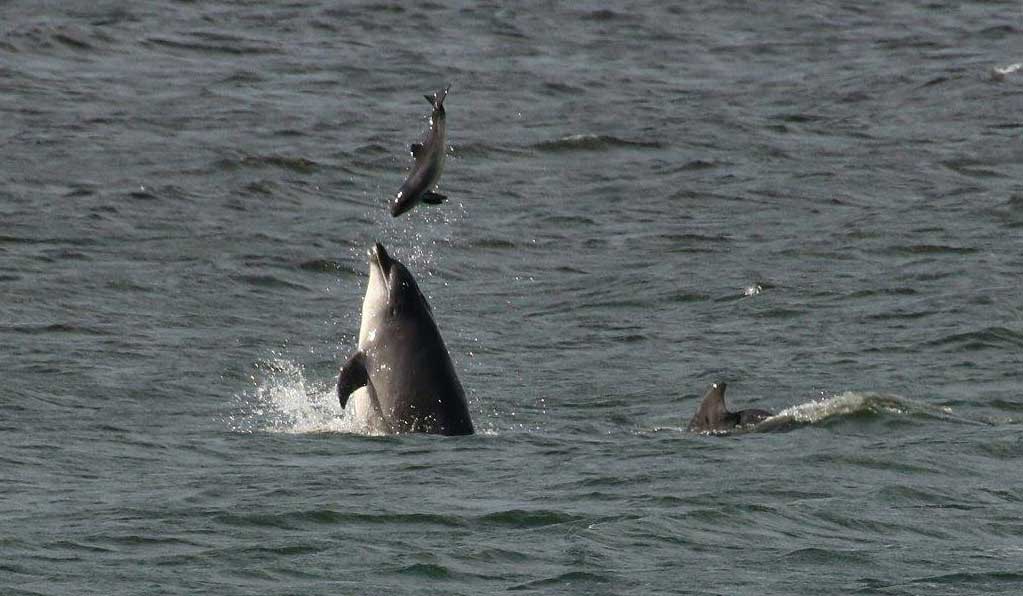 |
18
June 2016
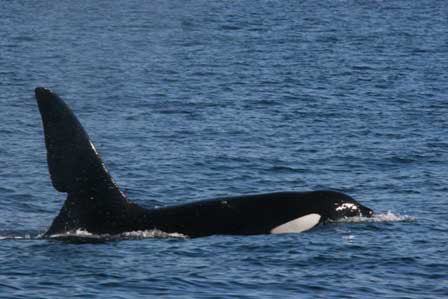 |
A
famous Killer Whale, Orcinus orca,
named 'John Coe",
distinguished by a large notch in its dorsal fin, was video-filmed off
west of the coast of Mull
swimming past the 'Cairns
of Coll', Inner Hebrides, Scotland. 'John
Coe" is the alpha male of the 'Hebridean
Community' of Killer Whales (or Western
Community) and has also been seen off Ireland
and Wales over the two decades, first recorded by its individual name in
1992.
Click
on the image
for the video recording.
|
Famous
Killer Whales (Hebridean Whale & Dolphin Trust)
June
2016
Basking Sharks,
Cetorhinus
maximus, make their annual summer pilgrimage
to the seas of the western coast of Scotland. The first image is a still
from aerial footage in calm seas off the Hebrides on 12
June 2016. The second still (from a video)
photograph shows a 3 metre long juvenile Basking
Shark with an adult. Click
on the images for the video recordings.
23
May 2016
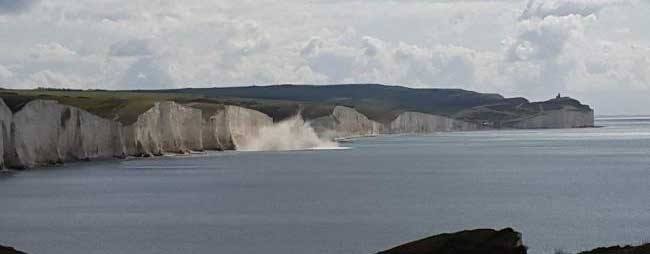
A large
cliff fall occurred of the chalk
cliffs at Seven
Sisters (west of Beachy
Head) on the East Sussex coast. Over ten metres of the land crashed
thousand of tonnes of chalk rocks into the sea when the tide
was high. The friable chalk is subject to
erosion and sudden cliff
falls can be treacherous for cliff walkers and also for rockpoolers
searching the chalk platform underneath.
Cliff
Fall Reports facebook
Coastal
Topography Gallery flickr
Birling
Gap Cliff Fall 2014
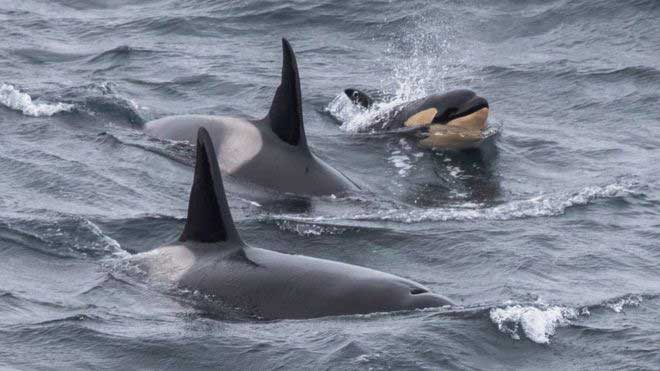 16
- 23 May 2016
16
- 23 May 2016
A
pod of about six Killer Whales, Orcinus
orca, including a three month old calf,
were spotted and photographed
off the Caithness
(NE Scotland) coast by wildlife watcher Karen
Munro on 16 May 2016.
The
pod were identified as a pod who spend the winter around Iceland feeding
on shoals of Herring.
The pod was spotted by Alan
Airey (Seawatch) in the Moray
Firth on 23 May 2016 and
was found by North
58 Sea Adventures to comprise of one bull,
three females, one juvenile and a calf. In
the last few years the same pod of whales have visited the Moray Firth
annually. The group is known in Scotland as
the Northern
Isles Community and moves between Iceland and Scotland to hunt
and raise young.
Moray
Firth Orca
Moray
Firth Dolphins
15
May 2016

A most
unexpected sighting of a juvenile Bowhead
Whale,
Balaena
mysticetus, occurred in shallow waters
at Long
Rock Beach, near Penzance,
Mount's
Bay, Cornwall. It is a species of right
whale usually only found in icy Arctic seas and there has only been
one
previous report last year. This juvenile
whale was about 7 metres long, but they can
grow up to 18 metres, and after the Blue Whale
they are heaviest animals (up to 90 tonnes) on the planet, with the longest
baleen
plates and the largest mouth. The
whale
was first spotted by regular marine mammal observer and medic, Dave
Jarvis of British
Divers Marine Life Rescue (BDMLR), and
first recognised by whale researcher Marijke
De Boer on a Marine
Discovery Penzance boat.
A brief
video footage shows the double blow of this whale species which together
with its distinctive shape confirms its identity. The
head is distinctive and this whale lacks a dorsal
fin.
28
April 2016
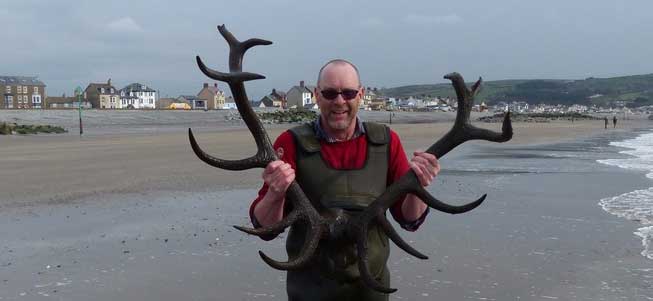
A spectacular
discovery of the skull and antlers of Red
Deer were recovered from the 3500 year
old petrified fossil forest
revealed on the low spring tides on the shore at
Borth,
Ceredigion,
on the
Cardigan Bay
west coast of Wales. Researchers from the
University
of Wales, Trinity Saint David, Lampeter, confirmed
that the find was preserved at the same time of the forest.
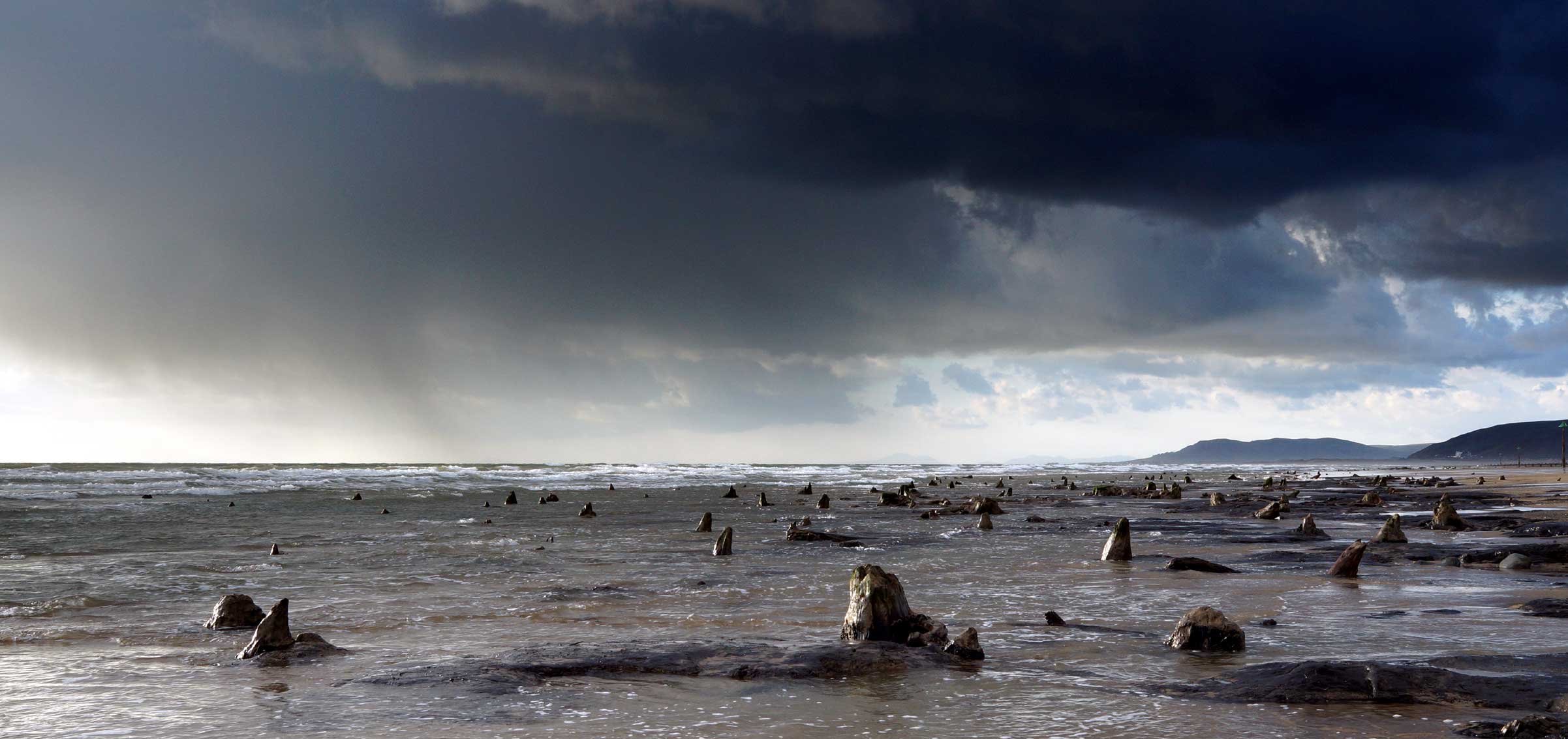
Submerged
Forest at Borth (exposed)
Photograph
by Bicky
Submerged
Forests of Wales
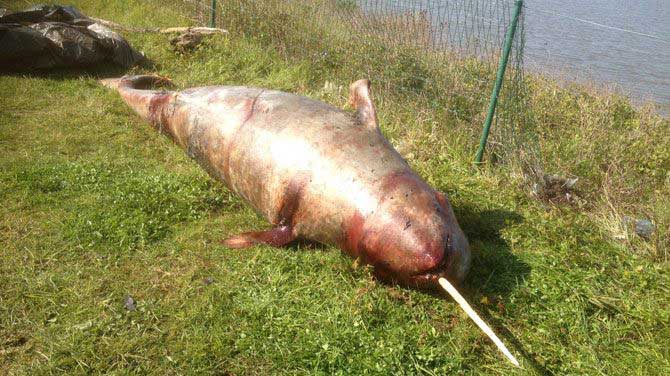 24
April 2016
24
April 2016
A
most extraordinary and unexpected discovery of a dead young male Narwhal,
Monodon
monoceros,
washed
up in the River Schelde
at Bornem in Antwerp
Province, was the first found on mainland European shores for over a century.
Only
the male Narwhals
have the single (usually) long ivory tusk. It is a toothed
whale almost always discovered in small
pods north of the Arctic Circle, so it was 1000 miles off course.
1
April 2016
Scientists
studying Scotland's resident population of Killer
Whales, Orcinus
orca, have identified an individual
animal which hit the headlines in the 1970s.
The orca
swam up the River
Foyle in Northern Ireland in November
1977. Efforts to persuade it to return to
the open sea failed until it decided to leave the river without help. The
Killer
Whale, named as Comet,
is now said be living in the waters off Scotland's west coast. Its identity
was discovered when old photographs were uploaded onto a facebook
page. Killer
Whale experts Andy
Foote and Hebridean
Whale and Dolphin Trust science officer Dr
Conor Ryan recognised the whale in the images
as Comet, last
recorded by the Trust off Dunvegan,
Isle of Skye, in September 2014.
Orcas
have an average life expectancy of 30 to 50 years in the wild. Their estimated
maximum life span is 60 to 70 years for males and 80 to more than 100 for
females.
Dr
Andy Foote said: “When I saw the photos on
facebook,
I noticed that the white eye patch of Dopey
Dick (media nickname) sloped backwards in a really distinctive fashion.
This is a trait we see in all the West
Coast Community whales, but it’s not that common in other Killer
Whale populations. The photographs were all
quite grainy, but it was still possible to see some of the distinctive
features unique to Comet.
I couldn't believe it – he was already a full grown male back in 1977.”
“Most
of what we know about this precariously small and isolated population of
Killer
Whales comes from photographs submitted to
us by members of the public. The population is too small to study in a
targeted way, so the public has a big role to play.”
BMLSS
Cetacea
British
Marine Life News 2013

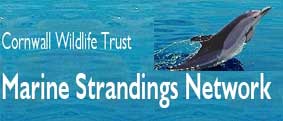
BMLSS
Oil Disasters page



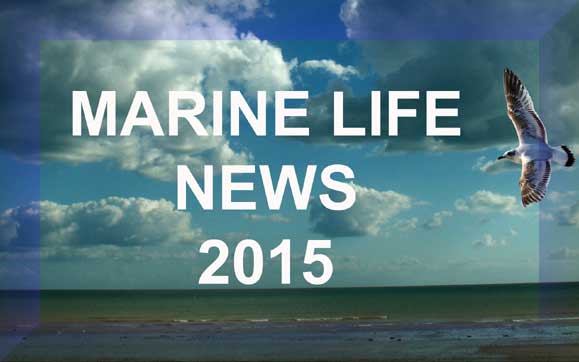
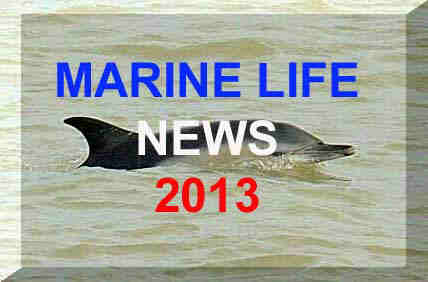
















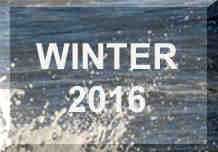
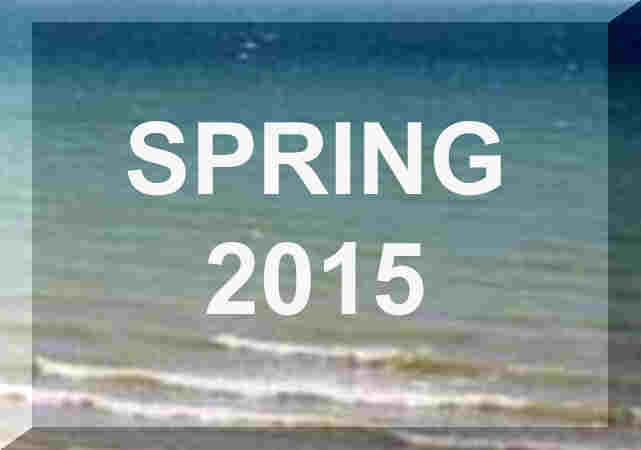








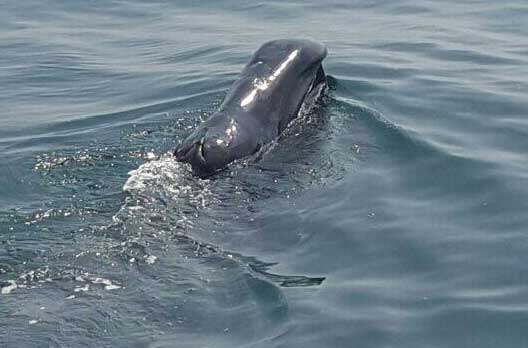





 24
April 2016
24
April 2016
